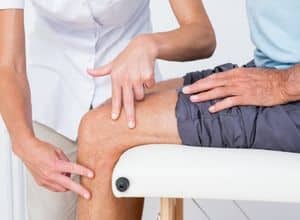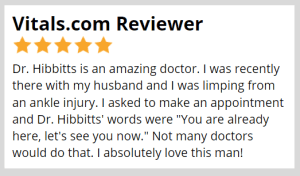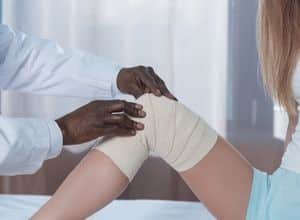
A specialist for knee injury can handle several cases a day because people of all ages often experience knee pain. The complexity of the knee causes many typical ailments to the joint. Over time, during athletic events or other activities, these accidents may happen.
Despite the tendency to ignore knee discomfort, no one should ever have to endure pain or weakness. Consult with a specialist for knee injury if you have redness, considerable swelling, or excruciating pain. They may go through your alternatives so that you can resume pain-free everyday activities.
Keep reading to find out more about knee discomfort and when you should see a specialist for knee injury.

The most prevalent kind of arthritis, osteoarthritis, is usually seen in the knees. Usually, it is the consequence of aging and wear and tear. Knee osteoarthritis is more common in women over 55 than in men. In people who are overweight, osteoarthritis may also be caused by heredity. Additionally, athletes with past knee problems or those who lift large weights often are more prone to have it.
Osteoarthritis treatment focuses on minimizing discomfort and recovering mobility. Your specialist for knee injury could initially advise weight reduction if the patient is overweight. Additionally, strengthening the joint with exercise. Your doctor could also suggest anti-inflammatory drugs, injections, or a brace.
Surgery is often reserved for extreme cases because we believe in conservative therapy. If, for instance, the knee responds well to corticosteroid injection and physical therapy, knee surgery is unnecessary.
A knee effusion develops when the amount of fluid in the tissues around the joint rises. While it may occur in any joint, the knee is one where it happens most often. Any injury or inflammation to the knee might cause an effusion. People with arthritis often get knee effusions (such as osteoarthritis, rheumatoid arthritis, and psoriatic arthritis). Knee effusion may also result from gout.
Usually, your specialist for knee injury would recommend drugs to treat knee joint swelling. Your doctor could suggest steroid pills or injections if those treatments are ineffective for treating your knee. Rarely does the swelling need surgery to be treated.
The knee is stabilized by the anterior cruciate ligament (ACL). The ACL, which links the thigh bone to the shin bone, is often injured when someone suddenly twists (which makes it a common injury for athletes).
Your doctor will examine you to determine the extent of the tear. Some ACL injuries don't need surgery to heal. Your specialist for knee injury would suggest you limit your activities (perhaps wear a brace) and go to physical therapy. Additionally, your doctor could suggest other therapies. Extremely complicated reconstructive surgery is often necessary to repair severe ACL injuries and replace the damaged ligament.
The meniscus, a rubbery disc, cushions your knee. Each knee has two menisci, one on each side. By distributing your weight evenly over your knee, they aid in maintaining knee stability. Usually, when the foot is on the ground, a sudden twist or spin may trigger a meniscus tear. As individuals age, crying is increasingly prevalent.

Meniscus tears occur in three grades: slight, moderate, and severe. Minor rips result in discomfort and edema, which usually go away in a few weeks. Moderate rips result in swelling, stiffness, and possibly severe pain while moving the knee. A knee with severe tearing may feel unstable and may suddenly give way. As bits of the torn meniscus travel into the joint, the knee may "pop."
The course of therapy depends on the extent of the meniscus tear. Depending on your degree of exercise, age, and the severity of the tear, your specialist for knee injury might advise rest, physical therapy, or arthroscopic surgery. The healing time after the minimally invasive procedure usually lasts four to six weeks.
Bursa inflammation is known as knee bursitis (small fluid-filled sacs that reduce friction and provide a cushion). People who kneel for extended periods (like gardeners, plumbers, etc.) have an increased risk of developing knee bursitis, along with those who play particular sports.
Knee bursitis may be treated with rest, physical therapy, an injection of corticosteroids, or aspiration (a procedure to drain excess fluid). Surgery is a last resort for bursitis and is typically only recommended to those who don't respond to other treatments or have recurrent/chronic bursitis.
Patellar tendonitis is a common inflammation or injury of your tendon that connects your kneecap (patella) to the shin bone. Patellar tendonitis often occurs from a repetitive impact on the knee caused by playing sports (especially sports that require a lot of jumping), doing household activities, and more. It is most commonly seen in middle-aged adults as tendons lose elasticity with age.

The kind of treatment depends on how serious the damage is. Your specialist for knee injury may recommend avoiding activities that aggravate the tendon and resting your knee. Applying ice to the joint can also be helpful. With more severe and persistent pain, your doctor may recommend corticosteroid injections, stem cell injections, or physical therapy. Surgery is rarely needed for tendonitis.
Knee pain could be a nuisance that causes you to miss work or cut back on fitness activities. By getting prompt medical attention for knee pain that persists longer than a week or two, you may be able to treat the condition with conservative measures that relieve the pain and get you back in action quickly.
It might be time to visit a specialist for knee injury if you suffer from any of the following, especially following an incident like an injury following athletics:
Chronic knee pain that isn't severe enough to require a trip to urgent care or the emergency room may signify a degenerative condition. Osteoarthritis is among the most common conditions affecting your knee and is a result of age-related changes to your protective cartilage of joints. This type of arthritis is unfortunately progressive, meaning it will continue to get worse. If you need to take pain relievers often times a month for knee pain, it is a tell-tale sign that you should see a specialist for knee injury.
Also, seek medical attention for knee pain accompanied by stiffness, swelling, and a limited range of motion. These are signs that an injury or condition exists. Many people ignore such signs, especially as they get older, because they think it's a part of normal aging. People who are overweight also think it's a normal symptom. However, nothing can further from the truth. Chronic knee pain, while very common, is not normal. Don't accept it as your fate. There are many treatment solutions available that can reduce or eliminate knee pain.
Here are some ways a specialist for knee injury treats knee pain.

A specialist for knee injury can administer ultrasound-guided cortisone shots as part of an extensive treatment plan for knee pain. Ultrasound is used for precision, and the combination of cortisone and anesthetic helps deliver long-lasting pain relief. Patients with acute and chronic knee pain can benefit from this therapy.
Another type of injection therapy is viscosupplementation, in which a specialist for knee injury injects hyaluronic acid (HA) into the knee to lubricate the joint. This is often recommended for patients with knee osteoarthritis who have lost the ability to lubricate the knee joint.
The HA will enhance the lubricating properties of the synovial fluid, which helps relieve pain and improve knee function. Viscosupplementation usually has long-lasting positive effects, with some patients reporting an improvement in symptoms for up to six months.
Many orthopedic doctors also employ regenerative medicine to relieve pain and boost injury healing. PRP therapy and stem cell therapy use components taken from the blood. During stem cell therapy, adult stem cells are harvested and injected into your knee to enable the healing of damaged tissue.
In PRP therapy, blood is taken from the body; platelets are concentrated and isolated using a centrifuge machine and injected into the knee. The platelets contain growth factors that could boost the repair and healing process. Patients with osteoarthritis and soft tissue injuries may benefit from stem cell therapy and PRP therapy.
A specialist for knee injury would usually exhaust conservative and minimally-invasive methods of treatment before recommending surgery. For patients who no longer respond well to nonsurgical treatment methods, doctors may recommend various surgical procedures, such as knee replacement, reconstruction of ligaments, repair of torn cartilage, removal of bone fragments, and more.